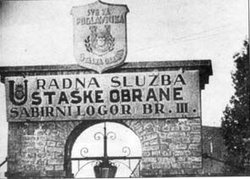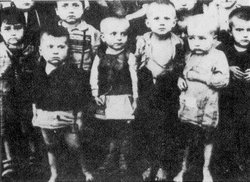Jasenovac concentration camp
|
|
Jasenovac was the largest concentration and extermination camp in Croatia during the World War II, and possibly the third largest in the world at the time. It was established by the Ustaša regime of the Independent State of Croatia in August 1941. It was dismantled in April 1945.
Jasenovac was a complex of five subcamps and three smaller camps spread out over 240 square kilometers (150 square miles), in relatively close proximity to each other, on the bank of the Sava river. Most of the camp was at Jasenovac, about 100 km (62 miles) southeast of Zagreb. The complex also included large grounds at Donja Gradina directly across the Sava river, a camp for children in Sisak to the northwest, and a women's camp in Stara Gradiška to the southeast.
| Contents |
The camp
Jaenovac_death_camp.jpg
The creation of the camp and its management and supervision were entrusted to Department III of a special police force called Ustaška Narodna Služba or UNS (lit. "Ustaše People's Service"). This organization was headed by Vjekoslav "Maks" Luburić, who was personally responsible for everything that happened. Several others were involved in commanding the camp at different times, including Miroslav Filipović-Majstorović and Dinko Šakić.
The Ustaše interned mostly Serbs in Jasenovac. Other victims included Jews, Gypsies, and opponents of the Ustaša regime. Most of the Jews were murdered there up to August 1942, when they started being deported to the Auschwitz concentration camp. Jews were sent to Jasenovac from all parts of Croatia after being gathered in Zagreb, and from Bosnia and Herzegovina after being collected in Sarajevo. Some came directly from other cities and smaller towns. On their arrival most were killed at execution sites near the camp: Granik, Gradina, and other places. Those kept alive were mostly skilled at needed professions and trades (doctors, pharmacists, electricians, shoemakers, goldsmiths, and so on) and were employed in services and workshops at Jasenovac.
The living conditions in the camp were extremely severe: a meager diet, deplorable accommodations, a particularly cruel regime, and unbelievably cruel behavior by the Ustaše guards. The conditions improved only for short periods during visits by delegations, such as the press delegation that visited in February 1942 and a Red Cross delegation in June 1944.
Similar to Nazi concentration camp badges, at first the prisoners were marked with colors: yellow for Jews, blue for Serbs, and red for communists, while Gypsies had no marks. This was later abandoned.
Mass murder and cruelty
The acts of murder and of cruelty in the camp reached their peak in the late summer of 1942, when tens of thousands of Serbian villagers were deported to Jasenovac from the area of the fighting against the partisans in the Kozara mountain (in Bosnia). Most of the men were killed at Jasenovac. The women were sent for forced labor in Germany, and the children were taken from their mothers; some were murdered and others were dispersed in orphanages throughout the country.
On the night of August 29, 1942, bets were made among the prison guards as to who could liquidate the largest number of inmates. One of the guards named Petar Brzica reportedly cut the throats of 1,360 prisoners with a especially designed butcher's knife (called srbosjek or Serb-cutter). Having been proclaimed the prize-winner of the competition, he was dubbed "King of the Cut-throats". A gold watch, a silver service, a roasted suckling pig, and wine were among his rewards. Historians have cast doubt on the number of inmates allegedly killed by Brzica, noting that Brzica would have had to kill 1.9 people per minute over a 12-hour period (with no breaks).
At the last moment, in January, 1945, more than 50,000 prisoners who were able to walk were led from the camp.
End of the camp
In April 1945 the partisan army approached the camp. The Ustasha attempted to erase traces of the atrocities. The camp of death worked at full capacity all the way to the end of April, 1945. Before leaving the camp around April 22nd, the Ustasha killed the remaining prisoners, blasted and destroyed the buildings, guard-houses, torture rooms, the "Picili Furnace" and the other structures.
Upon entering the camp, the liberators found only ruins, soot, smoke, and dead bodies. An escape attempt by the prisoners failed, and only a few survived.
During the following months of 1945, the grounds of Jasenovac were thoroughly destroyed by forced laborers, composed of 200 to 600 Domobran soldiers captured by the Partisans, thereby making the area a labor camp. They levelled the camp to the ground and among other things dismantled a two-kilometer long, four-meter high wall that surrounded it. Allegations have been made that the grounds in and around Jasenovac were also used to bury victims of the Bleiburg massacre, a Yugoslav reprisal against the Ustaše and others. It is known that a larger group of captives from Bleiburg was executed some ten kilometers away from the camp ground, and that some individual reprisal killings occurred in the area at the time, but a crime of a larger scale has not been confirmed.
Victim counts
Sava.jpg
Near or over a hundred housand people were murdered at Jasenovac, most of them Serbs. The number of Jewish victims was between 13,000 and 25,000; usually narrowed down to 17 to 18 thousand (out of a total of around 31-32,000 Jews killed in the NDH overall).
There are various statistics and estimates about the number of victims who died in the Jasenovac camp, mainly due to a lack of exact records, and to various interests involved in estimating them.
The National Committee of Croatia for the investigation of the crimes of the occupation forces and their collaborators stated in its report of November 15, 1945 that 500,000-600,000 people were killed at Jasenovac complex. These numbers were officially supported while Yugoslavia existed, yet the proponents of these numbers were subsequently accused of artificial inflation because of the war reparations.
Later analyses in the 1980s, notably by Vladimir Žerjavić showed that the in the Jasenovac complex death count was closer to 50,000 people, usually with margins of error of up to 30%, yet these numbers were accused of artificial deflation because of the rise of nationalism in Yugoslav republics.
The Jasenovac Memorial Area keeps a list of 59,188 names of Jasenovac victims collected by the Yugoslav authorities in 1964, and several other partial lists from other sources. The Belgrade Museum of the Holocaust gathered 77,743 names of Jasenovac victims by 1997, and over 80,000 as of 2005.
The approximations in the death count also come from the fact that in cases where entire families were exterminated, no one was left to submit their names to the lists.
Demise of the Ustaše
Ante Pavelić fled via Bleiburg to Austria, and few months later was transfered to Rome. It is alleged that he was hidden there by members of the Roman Catholic Church. Upon his arriving in Argentina, he became security advisor to Juan Peron. In April 1957 he was shot twice in an assassination attempt and forced to flee Argentina. Pavelić found refuge in Spain, where he died in Madrid in late 1959.
Miroslav Filipović-Majstorović was captured by the Yugoslav communist forces, tried and executed in 1946.
Maks Luburić fled to Spain but was assassinated by a Yugoslav agent in 1969.
Dinko Šakić fled to Argentina but was eventually brought to justice in the 1990s and sentenced by Croatian authorities to 20 years in prison.
Petar Brzica fled to the United States. His name was on a list of 59 Nazis living in the US given by a Jewish organization to the Immigration and Naturalization Service during the 1970s. Brzica remain unrevealed.
Later events
During the Yugoslav wars, the grounds of Jasenovac concentration camp and the Memorial area were temporarily abandoned due to the military conflict. In November 1991, Simo Brdar, a former associate director of the Memorial area collected the documentation from the museum and brought it with him to Bosnia and Herzegovina where he kept it until it was transferred to the United States Holocaust Memorial Museum in 2001 with the help of SFOR and the then government of Republika Srpska.
Bibliography
- The Yugoslav Auschwitz and the Vatican, Vladimir Dedijer (Editor), Harvey Kendall (Translator) Prometheus Books, 1992.
- Witness to Jasenovac's Hell Ilija Ivanovic, Wanda Schindley (Editor), Aleksandra Lazic (Translator) Dallas Publishing, 2002
- Crimes in the Jasenovac Camp, State Commission investigation of crimes of the occupiers and their collaborators in Croatia, Zagreb, 1946.
- Ustasha Camps by Mirko Percen, Globus, Zagreb, 1966. Second expanded printing 1990.
- Ustashi and the Independent State of Croatia 1941-1945, by Fikreta Jelic-Butic, Liber, Zagreb, 1977.
- Romans, J. Jews of Yugoslavia, 1941- 1945: Victims of Genocide and Freedom Fighters, Belgrade, 1982
- Antisemitism in the anti-fascist Holocaust: a collection of works, The Jewish Center, Zagreb, 1996.
- The Jasenovac Concentration Camp, by Antun Miletic, Volumes One and Two, Belgrade, 1986. Volume Three, Belgrade, 1987. Second edition, 1993.
- Hell's Torture Chamber by Djordje Milica, Zagreb, 1945.
- Die Besatzungszeit das Genozid in Jugoslawien 1941-1945 by Vladimir Umeljic, Graphics High Publishing, Los Angeles, 1994.
- Srbi i genocidni XX vek (Serbs and XX century, ages of Genocide) by Vladimir Umeljić, (vol 1, vol 2), Magne, Belgrade, 2004. ISBN:86-903763-1-3
- Magnum Crimen, by Vjenceslav Novak, Zagreb, 1948.
- Caput, by C. Malaparte, Napoli, 1943.
- Der koatische Ustasa-Staat 1941-1945, Schriftenreihe der Vierteljahreshefte fűr Zeitgeschichte, by L. Horry and M. Broszat, Stuttgart.
External links
- The Jasenovac memorial area: the official website (http://www.jusp-jasenovac.hr/index_en.php)
- US Holocaust Memorial Museum: Jasenovac (http://www.ushmm.org/museum/exhibit/online/jasenovac/)
- Balkan Repository Project - Jasenovac (http://www.balkan-archive.org.yu/Jasenovac/)
- Jasenovac commander Šakić trial documents by Republic of Croatia (http://public.srce.hr/sakic/materijali/eng/)
- Concentration camp Jasenovac, Archive of Republika Srpska (http://www.arhivrs.org/jasenovac.asp)
Controversial links
- Pavelic Papers' Documents on Jasenovac (http://www.pavelicpapers.com/documents/jasenovac/)
- Jasenovac Comitee of the Holy Assembly of Bishops of the Serbian Orthodox Church (http://www.jasenovac.info/?lang=en)
- Lord of the Danse Macabre, Ante Pavelic and the Independent State of Croatia (http://www.diacritica.com/degenerate/4/pavelic0.html)
- Kosta Brandic Archives: Jasenovac (http://www.balkan-archive.org.yu/kosta/jasenovac/)
- Gallery of Horror (http://www.balkan-archive.org.yu/kosta/jasenovac/jasenovac-galery_of_horror.html)
Jasenovac in the "Encyclopedia of the Holocaust"
- From the Jasenovac Research Institute (http://www.jasenovac.org/whatwasjasenovac/)
- From the Simon Wiesenthal Center (http://motlc.wiesenthal.org/pages/t034/t03448.html)
- From Srpska Mreza (http://www.srpska-mreza.com/sakic/history1.htm)de:KZ Jasenovac



